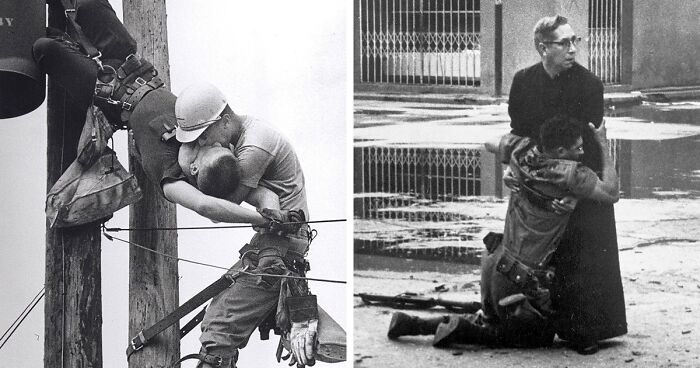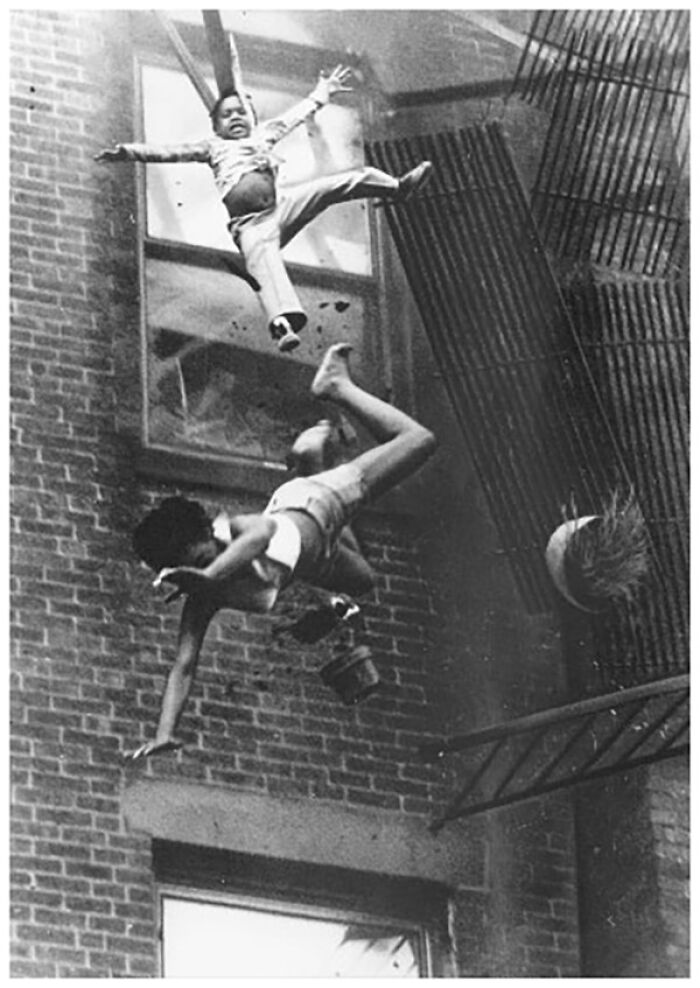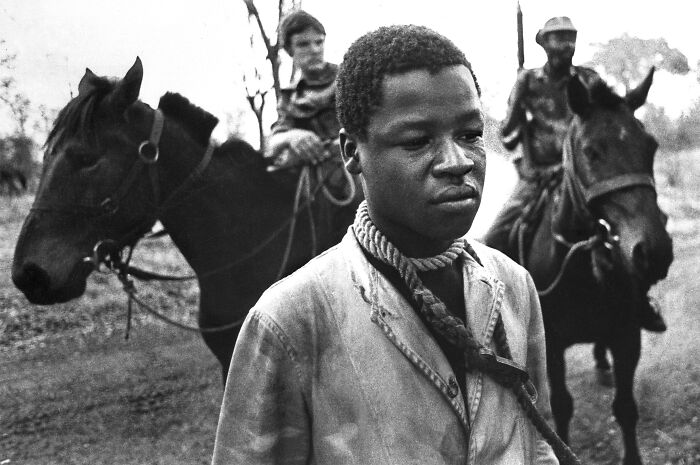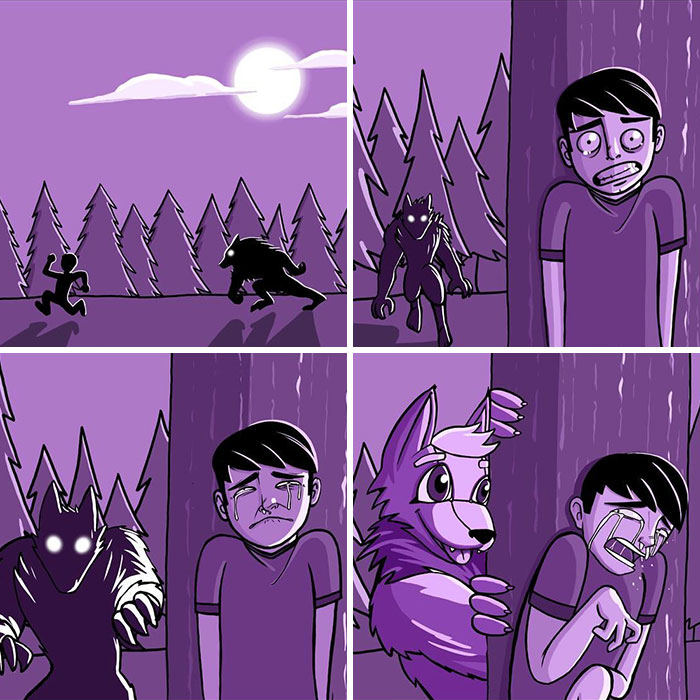
148Kviews
These 30 Pics Won Pulitzer Prize For Photography And Not Without A Reason
Photographs have such a great power to provoke thought and transmit emotion by cleverly telling stories about people in front of and behind the camera. Sometimes they portray events that were inspiring, uplifting, or even unexpected and shocking. Pulitzer Prize Award-winning photographs often have a tendency to catch the attention of spectators for their critical and challenging content as well as provoking very different reactions.
Patiently waiting for the photo opportunity to present itself or having to hide the camera from angry mobs, helping to save people’s lives, or simply immortalizing the very moment of survival or death—that’s what many of these photographers encounter while documenting the events. Numerous great photographers each year submit their work for the Pulitzer Prize, which showcases and celebrates outstanding achievements in American journalism.
This post may include affiliate links.
1968 "Kiss Of Life"
This photo had a quite dramatic background as the photographer, Rocco Morabito, was driving as he spotted an electrician hanging upside down on his safety belt struck by 4,160 volts of electricity. He called an ambulance and in the meantime, another lineman climbed up and successfully rescued his colleague by performing mouth-to-mouth and, well, Morabito was there to snap the shot of the scene winning the spot news prize.
Wonderful he knew what to do, my cousin died at Christmas because the people around her didn't know how to do cpr
1966 "Flee To Safety"
Another entry by a foreign photographer was the image of a South Vietnamese mother and children trying to swim across the river to escape the assault Operation Piranha. Once Kyochi Sawada’s picture won that year, he searched for the families in the actual photo and gave them half of the prize money.
Originally established in 1942 the photography award was later replaced by even two prizes that are still given out to this day. The following is a list of black and white photos from both Pulitzer Prize for Feature Photography and Pulitzer Prize for Spot News Photography (renamed Pulitzer Prize for Breaking News Photography in 2000) winners. Bored Panda invites you to set out on a journey through the images and the stories behind them admiring the sometimes complicated position of the photographer when it comes to positioning himself in extreme situations or getting involved in the stories themselves.
1958 "Faith And Confidence"
An image of police officer Maurice Cullinane and two-year-old boy Allen Weaver during a parade in Chinatown, Washington, DC. The policeman had warned the young boy against getting too close to the dragons, and that’s when William C. Beall caught the conversation on film and the Pulitzer Prize Board called it “an appealing picture which made a profound impression on readers.”
Ah yes, the good old days. (I remember this pic. Yes, I AM that old!)
1963 "Aid From The Padre"
The jurors admired the way drama, impact, and composition coexisted in this image taken by Hector Rondon. It is an image showing a wounded soldier pulling himself up to the priest. Rondon himself wasn’t sure how he managed to take the picture as the setting was quite rough: bullets flying around as it was taken during a rebellion of marines at a naval base close to Caracas, Venezuela that the photographer found out about.
1973 The Terror Of War
Nick Ut began taking pictures at the age of 16. Being injured 3 times himself, he carried on covering the Vietnam War and won the prize for this picture showing a 9-year-old naked Phan Thi Kim Phuc running towards the camera after a South Vietnamese napalm attack. Ut took her and other children to the hospital, where she ended up staying for 14 months, going through 17 surgeries, before finally returning home.
To this day, I still find this one of the most disturbing and heart-breaking photos showing the terror of war.
1969 "Coretta Scott King"
A photo of Coretta Scott King and her daughter Bernice in a moment of grief during Martin Luther King Jr.’s funeral in April, 1968 was taken by Moneta Sleet Jr. The day before the assassination, Martin Luther King Jr. assured his supporters that he was not afraid to die and that racial oppression could be defeated in the future.
1944 "Homecoming."
To take the “Homecoming” photo, Earle Bunker had to arm himself with patience for over 24 hours, waiting for the train that Lieutenant Colonel Robert Moore was coming back on after serving in WW2. Having been away from his family for 16 months, the soldier was reunited with his family and Bunker captured the very moment of it.
1976 "Fire Escape Collapse"
This Pulitzer Prize for photography winner by Stanley Forman immortalized the moment of a 19-year-old and her two-year-old goddaughter falling from the fire escape of a burning apartment in Boston that actually led to the adoption of new fire escape laws in the US. The little girl survived the fall as she landed on the godmother, who died hours later from multiple injuries.
1954 "Rescue On Pit River Bridge"
The first woman and the second amateur photographer to receive the Pulitzer Prize for Photography award, Virginia Schau, took a dramatic image on her Kodak Brownie camera that had only two exposures left on the roll. As she was taking her parents out for a day of fishing, they witnessed a truck accident that left the cab dangling 40 ft from Pit River Bridge. One of the people who helped to save the drivers was actually her husband.
1951 "Flight Of Refugees Across Wrecked Bridge In Korea"
Max Desfor was on photographer’s duty travelling with the American frontline troops during the war between North Korea and South Korea. On December 4th, 1950, while driving around Pyongyang, he noticed a bombed bridge that had hundreds of war refugees trying to make it across to the other side of the Taedong river. It was very cold and Max recalls that he could barely press the shutter button because of the freezing temperatures.
Just to think that people were so desperate that they risked life and limb to get across a bombed bridge
1945 "Raising The Flag On Iwo Jima"
More than iconic, this image happened to be surrounded by controversy regarding its authenticity. It was taken by Joseph Rosenthal during the final stages of the Pacific War, showing US Marines raising the flag on top of Mount Suribachi, the island of Iwo Jima. And it was so difficult to reach the point that the photographers started to doubt whether it was even worth it. “As the trail became steeper, our panting progress slowed to a few yards at a time. I began to wonder and hope that this was worth the effort, when suddenly, over the brow of the topmost ridge, we could spy men working with the flagpole they had so laboriously brought up about quarters of an hour ahead of us.“.
1955 "Tragedy By The Sea"
John L. Gaunt immortalized a tragedy of two parents by a rough sea realizing that they had just lost their child. The McDonalds were walking along the waves as their son Michael played nearby and crawled into the waves without them noticing.
1964 "Ruby Shoots Oswald"
Photographer Robert Hill Jackson was to cover the transportation of Lee Harvey Oswald to the country jail after being sentenced with the murder of President John F. Kennedy. As the action took place in the basement of Dallas police and courts building, Jackson had to strategically position himself to get the best shot possible, which he thought was obstructed by a man who, a moment later, jumped and fired a shot at Oswald as Jackson pressed the shutter button.
1960 "Last Rites Of Jose Rodriguez"
Former soldier Jose Rodriguez was among thousands of other people executed by the forces led by Fidel Castro. Here he is being given his final rites as he was sentenced to death by a firing squad. The photo was taken by Andrew Lopez, who covered the Cuban Revolution.
For me this photo is deeply moving, it must be awful knowing your minutes from death
1974 Burst Of Joy
Although the picture shows the ecstatic happiness of a family reunion the moment Col. Robert Stirm returned home from a prison camp in North Vietnam, it has a sad story. His wife, three days prior to the homecoming, sent him a letter informing him about the end of their marriage, so Stirm himself admitted having mixed feelings about the photo that was supposed to represent hope and healing.
That seems like some real shitty timing on her part. At least wait until the poor guy gets home to break the news in person.
1949 "Babe Ruth Bows Out"
The first picture in the sports field was taken during the final baseball game of George Herman Erhardt (AKA “Babe Ruth”). Although he was one of many photographers present that day, where Nathaniel Fein succeeded the most was taking a photo that really captured the moment of Ruth wearing the number 3 shirt and using his baseball bat as a cane while the whole stadium cheered. Ruth passed away two months after the photo was taken.
1961 "Tokyo Stabbing"
This situation during a heated election in Japan actually took place in front of 3000 people. As the situation got out of hand, one angry student drew a footlong sword that went 11 inches into this politician’s abdomen. And, well, Yasushi Nagao was there to freeze the exact moment as the student was pulling out the blade after the second thrust. As the image was reprinted in many American newspapers, it got Nagao the Pulitzer Award, making him the first foreign photographer to receive it.
The capturing facial expressions of everybody concerned is outstanding
1943 "Water!"
The second winner of the Pulitzer Prize for Photography, Frank (AKA “Pappy”) Noel, took the award-winning picture of a seaman in a lifeboat stretching his arm out for water—Noel himself was in another lifeboat in the Indian Ocean as his ship was torpedoed.
Why are there no comments here? To be in the worst possible situation and all you want is water... How absolutely terrible !
1978 "Three Photographs From Guerrilla Areas In Rhodesia"
The series of photos by J. Ross Baughman portraying the atrocities carried out by Rhodesian Security Forces on prisoners got their authenticity and details quastioned. As the debates went on, Baughman carried on his career and has lectured about journalistic ethics and methods at various universities and educational establishments.
1980 "Firing Squad In Iran"
Firstly, the prize was given to this photo anonymously in order to protect its author. It shows 11 Kurdish men being shot by Islamic supporters of Ayatollah Khomeni. Iran authorities pushed the newspaper to reveal the name, but the editorial staff refused. In 2016, with his permission, it was revealed that it was Jahangir Razmi who was behind the camera.
1942 "Ford Strikers Riot"
This image was taken during the 1941 workers’ strike at the Ford manufacturing plant. Apparently, Milton Brooks snapped it very quickly, hiding the camera behind his coat while mixing with the crowd so that he wouldn’t get noticed as, according to him, many people would have liked to wreck it.
1962 "Serious Steps"
The jurors were “impressed with the importance of thoughtful, significant pictures to illustrate the news." This image taken during a meeting regarding the Cuban Crisis between JFK and Dwight D. Eisenhower was taken during the moment when the secretary said “no more photos” and Paul Vathis snapped two shots from behind.
I've heard the comment asking what Ike was saying to JFK. The answer was "your left your left your left right left"
1947 "Death Leap From Blazing Hotel"
This picture of a fire incident killing 119 people in Winecoff Hotel in Atlanta, Georgia was taken by a 24-year-old graduate student from Georgia Tech. He took the gut-wrenching photo using a Speed Graphic and his last flashbulb. He ended up running an x-ray equipment business, although Associated Press offered him a job.
The “jumping lady” was Daisy McCumber, a 41-year-old Atlanta secretary who, contrary to countless captions, survived the 11-story jump. She broke both legs, her back, and her pelvis. She underwent seven operations rations in 10 years and lost a leg, but then worked until retirement. She died in 1992 aged 87, having never revealed even to family that she was the woman in Hardy’s photo. https://vintagenewsdaily.com/death-leap-from-blazing-hotel-the-story-behind-the-photo-taken-by-an-amateur-photographer-that-won-the-1947-pulitzer-prize/
1967 "Shooting Of James Meredith"
During the March Against Fear in Mississippi in 1966, James Meredith, who was a civil rights movement activist, was attacked and injured by a sniper and Jack R. Thornell took the winning photo.
1952 "Johny Bright Incident"
The sequence of photos taken by John Robinson and Don Ultang highlighted the racial tensions involving African American player Johnny Bright during an American college football game in Stillwater, Oklahoma. The photographers deliberately set up the camera focusing on Bright following numerous rumors of him being targeted. In some way, they were lucky to capture the images as they only planned to stay through the first quarter of the game, and that’s when Bright got knocked down three times by the opposing team and eventually received an elbow blow that broke his jaw.
1953 "Adlai Stevenson"
William M. Gallagher had to kneel at the base of the platform in order to snap this picture of Democratic presidential candidate Adlai Stevenson—in particular, the hole in his right shoe. Apparently, after the image was published, Stevenson received an “avalanche” of shoes.
1950 "Near Collision At Air Show"
On his day off, Bill Crouch was attending an air show with more than 60,000 spectators who were stunned by a near-collision of a biplane and a huge B-29. The latter was supposed to fly through the biplane’s smoke trail and ended up coming in too early, but, by chance, missing an awful tragedy.
1948 "Boy Gunman And Hostage"
The picture probably wouldn’t be so moving without its story of two 15-year-old boys—Ed Bancroft holding Bill Ronan as a hostage in an alley. As a robbery took place nearby, two policemen approached Ed asking about it. The boy pulled out a gun, shot one of the policemen, and took Bill as a hostage. Frank Cushing, the photographer, was on an assignment nearby, quickly assessing the best vantage point to take pictures of the events happening, which happened to be from a stranger's rear porch.
Wow, this is hard to believe that a child can be so hardened at that age
1970 "Campus Guns"
Steve Starr captured an epitome of student revolt against the general status quo in the campus of Cornell University, NY. It shows armed students leaving the building they had just taken over and held for 36 hours.
One of my ex-husbands 'occupied' the Paleontology Department at Berkley U. All by himself.
1957 "Andrea Doria Sinking 2"
The dramatic sinking of luxury sea liner Andrea Doria was captured from a small plane by Harry Trask suffering from airsickness. He got the pilot to make a few passes over the incident location that finally resulted in 16 pictures, including this particular one being selected by the Pulitzer Prize Board and the jury.
I don't think I'll ever get over the one of the couple whose child has just been lost. I wish I hadn't seen it.
Very recently the same thing happened in California. A man & his two sons we’re walking along the beach when a rogue wave came in & dragged them out to sea. The father & youngest son made it back to shore but the oldest son drowned.
Load More Replies...Literally took my breath away, the sadness and pain shown in these pictures moved me like no other post has. Suffering because the neglect of others, victims of conflict they had nothing to do with, and the dangers of everyday life. The background stories often changed the photos significance. The acts of courage and kindness that followed; changes to the law or simply increased awareness. It reminds me, "When elephants fight, it is the grass that suffers "
What struck me so profoundly is the amount of men in these photos creating devastating situations. We still have a lot to learn
I'm not sure much has can in this world; this is truly the saddest part
I'm writing to share an unpleasant experience, so that you can be aware if something similar happens to you. Recently, my mother lost a substantial amount of money after being scammed on Facebook, as someone had pretended to be one of her Facebook friends and defrauded her. I was desperate to help, so I looked on Google for possible solutions. To my relief, I found numerous good reviews of a company called Spyware Cyber. I took a chance, and they were able to help my mother retrieve her $200,000.00 USD. If you ever find yourself in a similar situation, I highly recommend getting in touch with them via Email: Spyware@cybergal.com Email: Contact@cybegal.net / WhatsApp +19892640381 Hope this information helps.
Well, bridezilla should have questioned her thinking. Never heard of such a thing. I wouldn't go unless it were a blood relation.
I don't like P. price. You can be sure photographers are looking for it. I know that since a riot in Paris at the Goldenberg restaurant in 1978. In a district with narrow streets in old Paris. Photo shooters rushed from nowhere. One put a cadaver on the counter. Took the picture. He won some price. CHEATERS! we know it. Like the ones who give you money for having a good view from your window house. Happened to me for a French president in Jarnac, France. Or other disguise themselves. Crappy profession
Don't blame the messenger. Without them we would never know!
Load More Replies...An excellent post, too much sadness, but great stories, as well as the photography !!!
Powerful stuff, but will it ever happen again? Emotions and stories captured on candid faces, but today faces are vlurres or covered due to privacy guidelines.
I don't think I'll ever get over the one of the couple whose child has just been lost. I wish I hadn't seen it.
Very recently the same thing happened in California. A man & his two sons we’re walking along the beach when a rogue wave came in & dragged them out to sea. The father & youngest son made it back to shore but the oldest son drowned.
Load More Replies...Literally took my breath away, the sadness and pain shown in these pictures moved me like no other post has. Suffering because the neglect of others, victims of conflict they had nothing to do with, and the dangers of everyday life. The background stories often changed the photos significance. The acts of courage and kindness that followed; changes to the law or simply increased awareness. It reminds me, "When elephants fight, it is the grass that suffers "
What struck me so profoundly is the amount of men in these photos creating devastating situations. We still have a lot to learn
I'm not sure much has can in this world; this is truly the saddest part
I'm writing to share an unpleasant experience, so that you can be aware if something similar happens to you. Recently, my mother lost a substantial amount of money after being scammed on Facebook, as someone had pretended to be one of her Facebook friends and defrauded her. I was desperate to help, so I looked on Google for possible solutions. To my relief, I found numerous good reviews of a company called Spyware Cyber. I took a chance, and they were able to help my mother retrieve her $200,000.00 USD. If you ever find yourself in a similar situation, I highly recommend getting in touch with them via Email: Spyware@cybergal.com Email: Contact@cybegal.net / WhatsApp +19892640381 Hope this information helps.
Well, bridezilla should have questioned her thinking. Never heard of such a thing. I wouldn't go unless it were a blood relation.
I don't like P. price. You can be sure photographers are looking for it. I know that since a riot in Paris at the Goldenberg restaurant in 1978. In a district with narrow streets in old Paris. Photo shooters rushed from nowhere. One put a cadaver on the counter. Took the picture. He won some price. CHEATERS! we know it. Like the ones who give you money for having a good view from your window house. Happened to me for a French president in Jarnac, France. Or other disguise themselves. Crappy profession
Don't blame the messenger. Without them we would never know!
Load More Replies...An excellent post, too much sadness, but great stories, as well as the photography !!!
Powerful stuff, but will it ever happen again? Emotions and stories captured on candid faces, but today faces are vlurres or covered due to privacy guidelines.

 Dark Mode
Dark Mode 

 No fees, cancel anytime
No fees, cancel anytime 






























































































